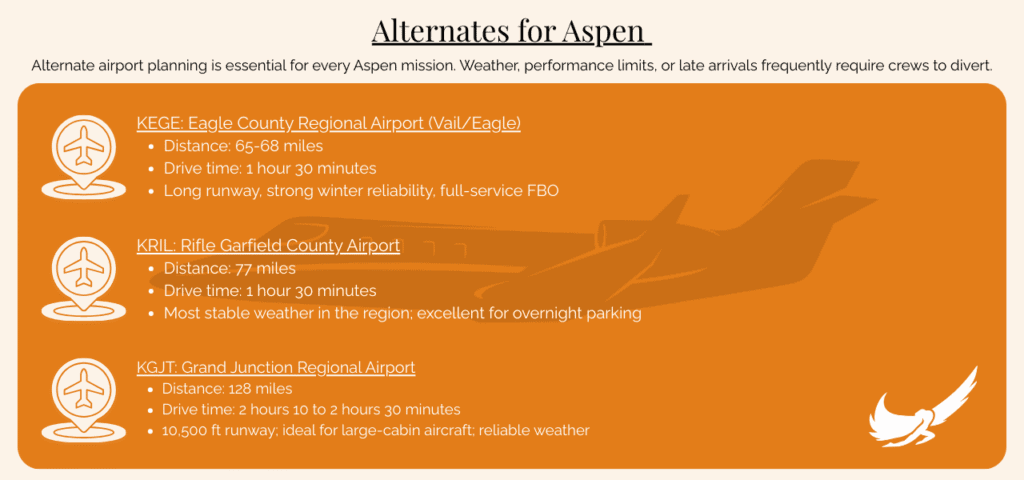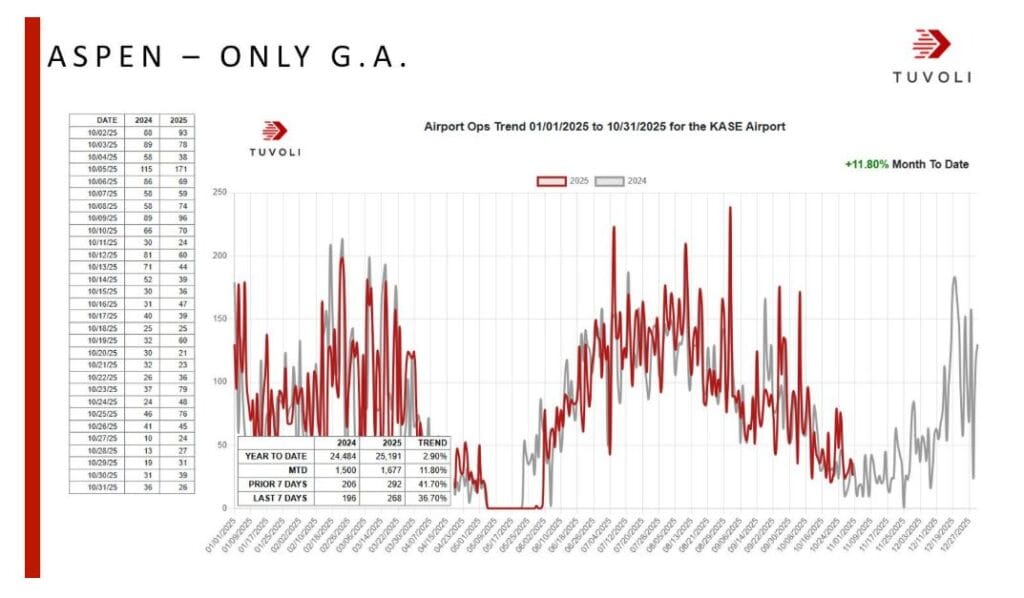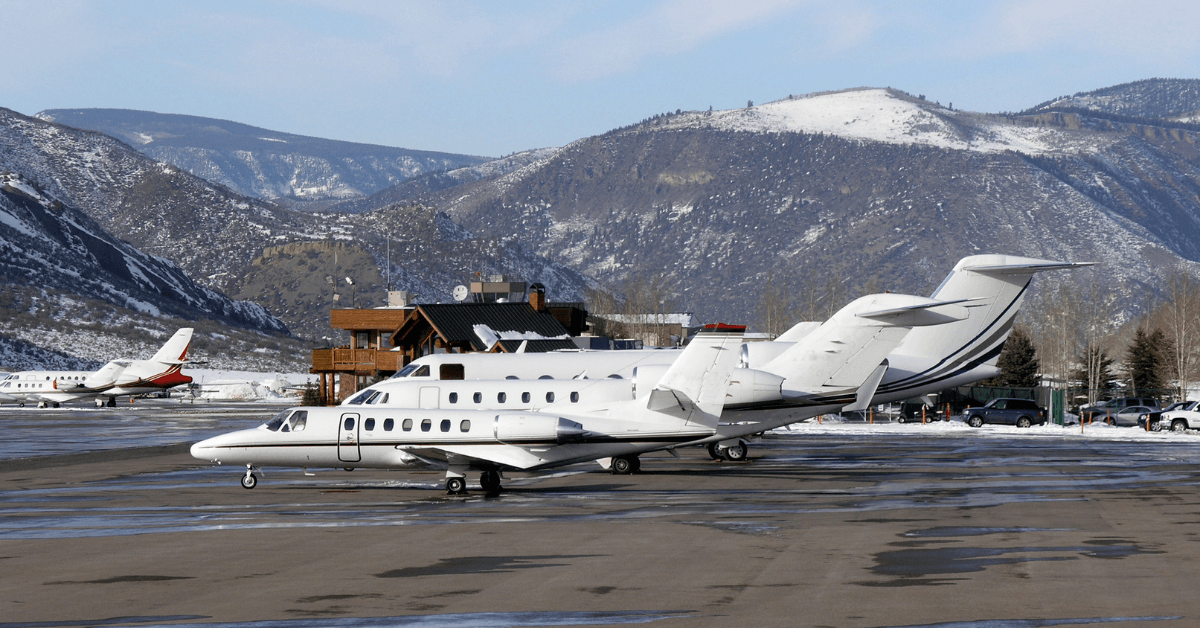Aspen/Pitkin County Airport (KASE), also known as Sardy Field, is regarded as one of the most demanding airports in North America. Factors that make it challenging for aircraft operations include topographical constraints, altitude, strict operating hours, weather unpredictability, and seasonal peaks. Consequently, planning for flight support operations has become equally vital.
The below insights describe the primary operational limitations, costs, performance factors, alternate airports, FAA activity statistics, and an organized approach to supporting flights approaching KASE.
Hours of operation
One of the most crucial elements in mission plans is Aspen’s operating constraints. No aircraft may arrive or depart outside the published operating hours.
Airport hours
- First wheels-in/out: 0700
- Last wheels-out: 2229
- Last wheels-in: 2259
- Airport closed: 2300-0700
Atlantic Aviation (FBO) hours
- Front Desk: 0600-2200
- Line Service: 0600-2300
Even for minor delays such as de-icing chokepoints, late-arriving passengers, ATC flow restrictions, and deteriorating weather, overnight is common. Crew members must brief the passengers accordingly: Once the airport closes, exceptions are not allowed at Aspen.
Fees, parking, and hangar information
Aspen’s fee environment and shelter limitations require careful planning, especially during winter conditions.
Fees (in USD dollars)
- Facility Fee: 4,023 (waived with 990 gallons uplift)
- Habitat Fee: 25
- Security Fee: 150
Parking
- First hour: complimentary
- Next 11 hours: 203 per hour
- After 12 hours: 110 per hour
Hangars
- Base: 4,247 plus 354 per hour
- Maximum accepted wingspan is 95 FT. This means that a G650 or similar cannot operate in KASE, as the G650 aircraft has 99.60 feet of wingspan.
- Limited availability, especially during storms or peak events
Key notes
- No slots
- No PPR
- No fuel shortages
- Ramp parking is generally available
- Hangars must be requested early in high season
Operational considerations
A safe and efficient operation into Aspen begins with recognizing the constraints that affect every arrival and departure. Elevation, terrain, and weather impose real limits on aircraft performance, crew decision-making, and turnaround times. Here’s out take on the key operational aspects of your next flight into Aspen.
High-elevation performance limits
At 7,820 ft, density altitude sharply affects flight performance. Crews must anticipate:
- Reduced takeoff performance
- Climb gradient limitations
- Payload restrictions
- Missed approach challenges
Terrain and approach design
KASE is surrounded by steep terrain that dictates:
- Strict stabilization criteria
- Limited escape routes
- Defined missed approach profiles
- Careful altitude management
Weather volatility
Seasonal patterns can cause:
- Snow, ice, and slush
- Valley fog
- Mountain-wave turbulence
- Low visibility
- Rapid weather changes
These conditions routinely lead to holding or diversions.
Seasonal congestion
Winter and summer peaks generate:
- Longer taxi times
- High demand for de-icing
- Fuel delays
- Ramp congestion
These conditions reinforce the need for detailed trip-support planning.
Want to learn more about why Aspen is such a challenging airport even for seasoned pilots? Read this opinion piece by our Founder and CEO Kevin Singh, Instructor Pilot for the Global 6000 Program.
Why Aspen Airport Challenges Even the Most Seasoned Pilots
Alternates for Aspen
Alternate airport planning is essential for every Aspen mission. Weather, performance limits, or late arrivals frequently require crews to divert.


KEGE: Eagle County Regional Airport (Vail/Eagle)
- Distance: 65-68 miles
- Drive time: 1 hour 30 minutes
- Long runway, strong winter reliability, full-service FBO
KRIL: Rifle Garfield County Airport
- Distance: 77 miles
- Drive time: 1 hour 30 minutes
- Most stable weather in the region; excellent for overnight parking
KGJT: Grand Junction Regional Airport
- Distance: 128 miles
- Drive time: 2 hours 10 to 2 hours 30 minutes
- 10,500 ft runway; ideal for large-cabin aircraft; reliable weather
KMTJ: Montrose Regional Airport
- Distance: 133-136 miles
- Drive time: 2 hours 45 minutes to 3 hours
- Lower congestion; strong winter capability
APA: Centennial Airport (Denver Area)
- Distance: 211 miles
- Drive time: 4 hours (weather dependent)
- 24-hour business aviation operations; useful for widespread weather events
KPVU: Provo Airport (Utah)
- Distance: 260 miles
- Drive time: 4 hours 15 minutes
- Useful long-range alternate to the west
KTEX: Telluride Regional Airport
- Distance: 193 miles
- Drive time: 4 hours
- High elevation and challenging terrain; for mountain-qualified crews only
Recommendation: Pre-coordinate alternate parking and handling before departure with a trusted trip support parter like Icarus Jet.
Aspen Pitkin by the numbers
Public FAA Air Traffic Activity Data System (ATADS) figures show Aspen as a private-aviation-driven airport with high seasonal volatility.
Operational Breakdown
- General Aviation: 52%
- Air Taxi (Part 135): 29%
- Scheduled Commercial: 18%
- Military: 1%
More than 80 percent of movements are private aviation or charter, which drives ramp demand and increases sensitivity to weather and timing constraints.
2024 monthly operations (FAA ATADS)
2024 movement totals show Aspen’s predictable peak rhythm.
- January: 4,523
- February: 4,970
- March: 5,118
- April: 2,434
- May: 1,027
- June: 4,222
- July: 6,016
- August: 5,884
- September: 4,389
- October: 3,313
- November: 2,120
- December: 4,486
Seasonal Takeaways
- Peak seasons: January-March and June-August
- Busiest month: July
- Lowest activity: May and November
- December surge: Holiday and early ski travel
These numbers confirm that Aspen’s traffic profile remains high throughout the year, with very narrow low-activity windows.
2025 activity trends (Tuvoli data)
Tuvoli’s real-time private aviation data for 2025 shows Aspen operating above historical averages:
- 11.8% month-to-date increase
- 2.9% year-to-date increase
- 268 operations in the past 7 days (vs 196 last year)
Mid-summer and early autumn spikes indicate that even traditional “shoulder months” are no longer low-traffic periods. This trend increases the value of early hangar and alternate coordination.

Trip support plan for Aspen
Icarus Jet supports every step of a disciplined, six-stage planning approach for every Aspen mission.
1. Pre-trip coordination
- Book hangar space
- Pre-book alternate airports
- Review NOTAMs and runway conditions
- Ensure passenger schedule matches airport hours
- Plan for fuel uplift on arrival
2. Weather and performance planning
- Review valley and mountain weather
- Run high-elevation performance models
- Brief escape and missed approach procedures
- Anticipate crosswind or turbulence impacts
3. Alternate planning
- Pre-coordinate parking at KEGE, KRIL, KGJT, or KMTJ
- Calculate fuel for holding and diversions
- Validate crew duty limits
4. FBO coordination
- Confirm line service timing
- Request hangar access if weather deteriorates
- Coordinate de-icing procedures
5. Passenger and crew logistics
- Book crew accommodations early
- Book ground transport for Aspen and alternates
- Communicate the importance of arrival punctuality
6. Departure management
- Reconfirm weather and runway condition codes
- Ensure climb performance meets gradients
- Expect delays during busy morning and late-afternoon periods
Conclusion
Aspen is a high-demand airport at high elevations. This airport requires strict operational plans. Weather variations and strict operating schedules provide less room for error. FAA public data indicates high demand in both general and charter operations at Aspen Airport in 2025.
By adopting an organized approach to trip support and coordinating alternates in advance, crews from the private aircraft industry will be able to fly safely and conveniently into the Aspen area year-round.
FAQs
1. Do I need slots or PPR to operate into Aspen?
No, Aspen has neither requirement.
2. What are Aspen’s operating hours?
2300–0700 closure. Last wheels-out 2229, last wheel-in 2259.
3. Can large-cabin aircraft be hangared?
No. G650-class aircraft cannot be accommodated.
4. What fees should I expect?
A facility fee of 4,023 (waived with 990 gallons), plus habitat, security, and parking fees.
5. Is Aspen prone to diversions?
Yes. Weather and low visibility frequently require alternates.
6. What are the main alternates?
KEGE, KRIL, KGJT, and KMTJ.
7. Does Aspen have customs?
No. International arrivals must be cleared in the nearest airport like KEGE and KDEN then proceed to KASE.




